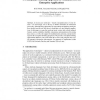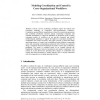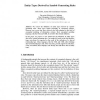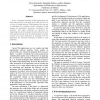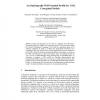ER
2009
Springer
14 years 4 months ago
2009
Springer
Ontological metamodeling or multilevel-modeling refers to ng complex domains at multiple levels of abstraction, especially in domains where the borderline between individuals and c...
COOPIS
2002
IEEE
14 years 4 months ago
2002
IEEE
Abstract. In recent years ontologies – shared conceptualizations of some domain – are increasingly seen as the key to further automation of information processing. Although man...
COOPIS
2002
IEEE
14 years 4 months ago
2002
IEEE
Current e-service technology paradigms require the analysis and conceptual modeling of cooperative inter-organizational workflows. Cooperation among different organizations is base...
ER
2003
Springer
14 years 4 months ago
2003
Springer
Abstract. We review the definition of entity types derived by symbolgenerating rules. These types appear frequently in conceptual schemas. However, up to now they have received ver...
LAWEB
2003
IEEE
14 years 4 months ago
2003
IEEE
So far, conceptual modeling of Web applications has been used primarily in the upper part of the life cycle, as a driver for system analysis. Little attention has been put on expl...
COOPIS
2003
IEEE
14 years 4 months ago
2003
IEEE
This paper discusses some of the implications of introducing the dynamic object role concept into object-oriented metamodels on both implementational and conceptual modeling levels...
ER
2004
Springer
14 years 4 months ago
2004
Springer
An open challenge is to integrate XML and conceptual modeling in order to satisfy large-scale enterprise needs. Because enterprises typically have many data sources using differe...
CAISE
2004
Springer
14 years 4 months ago
2004
Springer
UML class diagrams can be used as a language for expressing a conceptual model of a domain. In a series of papers [1,2,3] we have been using the General Ontological Language (GOL) ...
SELMAS
2005
Springer
14 years 5 months ago
2005
Springer
Despite the relevance of the concept of role for conceptual modeling and agent-orientation, there is still in the literature a lack of consensus on the meaning of this notion and h...
MICAI
2005
Springer
14 years 5 months ago
2005
Springer
In Multi-agent based simulation (MABS) systems, computational models are built as multi-agent systems (MAS). Replication of these models can contribute to improve the reliability o...

